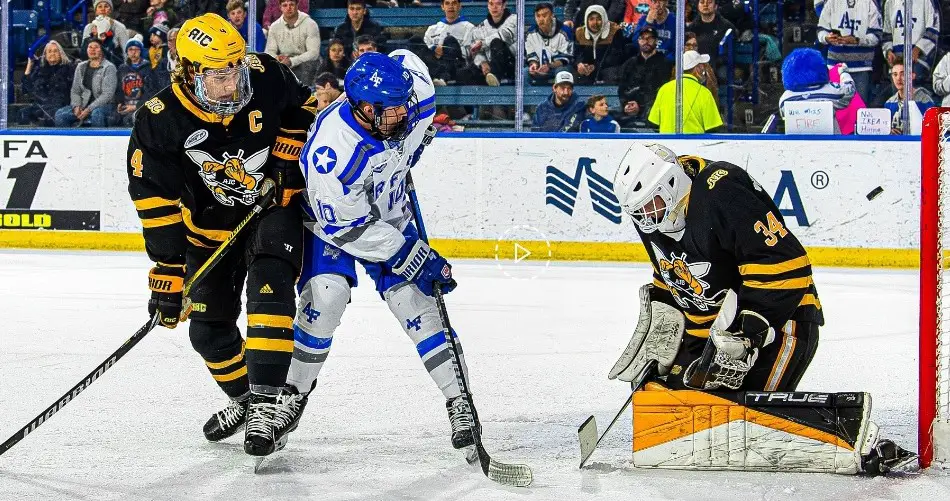
Each week during the season, we look at the big events and big games around Division I men’s college hockey in Tuesday Morning Quarterback.
Paula: Oh, Dan, this is absolutely my favorite time of the hockey season – conference playoffs. When I first started covering college hockey decades ago, Bob Daniels told me that the conference championship is an achievement to be cherished on its own, that it should never be seen only as a play-in to the NCAA tournament.
There’s pride, Daniels said, in besting everyone else you’ve battled for half a year and pride in raising that conference banner at the start of the following season.
Daniels also told me that it’s hard to end another team’s season. That is a lesson that Wisconsin learned Sunday evening.
What an upset. Last-place Ohio State took a best-of-three quarterfinal series against Wisconsin – the second seed in the Big Ten tournament, the then-No. 5 team in the country, a top-10 PairWise team and the home team as well – with wins Friday and Sunday.
And Sunday wasn’t even close. The Buckeyes led the entire game and the Badgers looked outplayed for most of the contest. Experience was a big factor in the series. Even though Ohio State had four B1G wins this season, there are a lot of players on this team that went to the NCAA tournament last year. That can’t be underestimated.
But Ohio State wasn’t the only team to pull an upset in playoff action. In the ECAC, last-place Rensselaer – with six conference wins in the regular season – beat fifth-place Clarkson in a single-elimination, pre-quarterfinal playoff round.
With Hockey East and the NCHC having concluded their regular seasons last weekend, everyone’s in playoff mode now.
What do you take away from the first weekend of playoff hockey? What are you looking for this coming weekend?
Dan: I’ve made the comment several times that single-elimination playoffs are significantly more unpredictable than the best-of-three series, and sure enough, for the second week in a row, a last-place seed knocked off the best available opponent when RPI defeated Clarkson to advance to the second round of the ECAC postseason.
I’m probably going to hate myself for saying this, but even as the ECAC beat writer, I never saw that one coming, and I spent time last week talking with good friend Ken Schott about if RPI coach Dave Smith faced any employment troubles because facing a last-place finish was such a rarity for the program. As much as I hate having that discussion and that I have no insight into a school’s hiring or firing process, I couldn’t disagree that the season struggled behind a really poor special teams showing that included a penalty kill well below 70 percent – behind an expansion Stonehill team when the game dropped the puck last week as No. 64 out of 64.
On the other hand, Clarkson was probably the best ECAC team behind Quinnipiac and Cornell, and I personally thought the Golden Knights belonged in fourth place despite Dartmouth’s ability to avoid losing games in regulation. That said, the Engineers built a 3-0 lead and held onto win through a third period where the Golden Knights outshot them 22-3! That penalty kill, by the way, didn’t allow a goal despite giving four power play attempts when it was running once-every-three-attempts with a goal allowed.
Then again, that’s playoff hockey for you, and that’s what makes the single-elimination format so enthralling. I personally like the best-of-three format better because it forces teams to do more than have the right game in the right place, but the drama would’ve gotten much shorter if RPI had an extra game or two to pick up that second win. I felt the same way when Bentley-Robert Morris went to overtime during the Atlantic Hockey first round, and I was equally crushed when Bentley lost, though I was pretty happy to see good friend Derek Schooley advance to the second round.
Coming back to the playoffs for a bit, RPI’s advancement opens the door for a prickly situation in ECAC because Quinnipiac now draws a team playing with house money in the second round. Crazy at it sounds, a Quinnipiac team situated around No. 8 or No. 9 in the Pairwise Rankings absolutely cannot lose a game in this series without tumbling a bit because RPI sits down around No. 54. Doing some quick math, one loss – even without factoring in games by Michigan or Colorado College or Omaha or Western Michigan – would drop the defending champs down to around the No. 12 spot. Another loss – particularly at home and in a sweep format – would knock them entirely out of the Pairwise.
ECAC is in danger of only having one bid to the tournament anyways, but this is probably my biggest underpinning storyline, especially after watching Wisconsin drop to Quinnipiac’s location after losing twice to Ohio State.
How volatile are some of these spots for you, and which teams should definitely be worried about their postseason lives in the conference tournament?
Paula: That is an excellent question.
In the Big Ten right now, there are four teams in the tournament – Michigan State, Minnesota, Wisconsin and Michigan. Ohio State is No. 28 in the PWR, so a loss to the Buckeyes for the remaining teams in the B1G playoff field would certainly drop them, but I honestly don’t see a scenario that has any of these teams dropping out of NCAA tournament range even if the Buckeyes win.
Michigan State, fifth in the PWR, wouldn’t drop enough to be out with a loss to Ohio State next weekend. The winner of the OSU-MSU game plays the winner of the Michigan-Minnesota semifinal. Minnesota’s in sixth place, so if the Gophers win and then lose to the Buckeyes in the title game, Minnesota won’t take enough of a hit to drop out.
If Michigan and Ohio State both advance to the Big Ten title game – a dream matchup for so many earnest, hate-filled (I say that with love) fans – the No. 10 Wolverines would already have beaten a team higher in the PWR to get to the title game, so a loss to Ohio State shouldn’t drop them out of contention, either.
I know there are lots of other mathematical possibilities here and many other scenarios in play, but I don’t see the Big Ten without four teams in the NCAA tournament – five in the unlikely event that the Buckeyes win out.
An aside: I say “unlikely” because Ohio State has had difficulty putting together back-to-back wins this season. They do have a three-game B1G win streak from when they swept Wisconsin and then took their first game against Michigan State a couple of weeks ago. As you’ve said, anything can happen in single-elimination hockey.
Getting back to the conference playoffs themselves, though, I see really exciting things in every league. This four-team field in the Big Ten has such a sweet old-school CCHA feel to it that warms my heart.
Look at the Hockey East playoffs. Single elimination all the way through, with a bunch of teams that will advance from Wednesday’s opening round that can do a little PWR damage themselves against quarterfinal opponents – not in any way that would knock Boston College, Boston University or Maine out of the NCAA tournament, but BC or BU could potentially lose a top regional seed spot with a loss in quarterfinal play.
And then there’s Providence and Massachusetts, two PWR bubble teams that meet in Saturday’s quarterfinal round.
In the NCHC, there are four teams that can either play their way into or out of the NCAA tournament: Colorado College (11), Omaha (11), Western Michigan (13), St. Cloud State (15). North Dakota and Denver are high enough to be safe, but those are potential top seeds in regionals, too.
I have to admit that the conference playoffs that interest me the most right now are Atlantic Hockey and the CCHA. I circle around again to the point I made at the start of this column, that conference championships themselves are something to fight for. Yes, the winner gets an autobid, but that doesn’t undercut the importance of the conference title itself – especially in conferences where the battle has been so intense.
Look at the AHA. At the end of the season, there were five points separating second-place Holy Cross and seventh-place Niagara. It’s exactly the same in the CCHA, with five points between second-place and seventh-place Lake Superior State. Fortunes will be made and lost in the AHA and CCHA playoff semifinal games.
While we’re talking about who’s in and how far they can go, my mind also turns to who’s out and who’s about to be out. With 24 wins on the season, Arizona State is out. At least one Atlantic Hockey team with 20 or more wins will be out, too. You mention the possibility of the ECAC sending just one team to the NCAA tournament.
These realities strike me as unfair – even as part of my brain screams, “Win more games!” Is this a byproduct of how good college hockey has become, or are there other factors at play here, Dan?
Dan: I wish there was a clear-cut reason that I could point you in the right direction, but it’s way more complicated than just a simple reason. No one year dictates where the proverbial Delorean lands when it hits 88 mph, but no season is an indicator of where things are going. If that were the case, Boston College would’ve never finished eighth in back-to-back seasons, and it likewise would’ve never rebounded to become the No. 1 team in the first place.
I think there are a number of reasons why leagues rise and fall on an annual basis. Coaches and players, cultures, buy-in, chemistry, it all counts for a good chunk of the pie, but team-building is more than just recruiting a kid to a top-notch program or school nowadays.
The portal and NIL are here, and I don’t quite know the degree of its impact on an ever-evolving world. I’d love to sit down and draw connections between programs with more robust NIL and the general size of their programs’ successes. I’m sure, for example, that the Big Ten knows how to get kids involved with NIL, but Atlantic Hockey schools would be lucky to have a staff member who understands the landscape. I’m not quite sure how to measure that, though, and I don’t want to start pointing fingers before I get too deep.
That said, I think there is, at least, an ongoing conversation about facilities, even if it’s not the only discussion nowadays.
In light of that, Maine announced a $320 million facilities renovation! I actually thought it was a typo, but after looking up several sources, it’s true (and extends beyond just one area). Robert Morris, meanwhile, is reportedly looking into grant-funding that would get a new arena built for that program.
Beyond the general impact, is there a place you’ve visited that you think deserves a facelift? Out east, I think about Hockey East and ECAC, and I personally would love to see a couple of changes to some places. Not that there’s anything wrong with the buildings in question, but I would love to see what Tsongas Center at UMass Lowell or Conte Forum at BC could do with a couple of different changes or updates. Two great places to watch games and be part of the action, it’s worth noting.
As I kick this over to you, is there a place in mind?
Paula: The Big Ten venues are all way beyond adequate. The renovations to one of the best old barns in the game, Munn Ice Arena, have made it a stunning facility. Its capacity is just right for college hockey and the improvements are as stylish as they are state-of-the-art.
Wisconsin gets its ice whittled down to NHL size next season, so there’s that.
Everyone familiar with Ohio State hockey knows that the Buckeyes need a hockey-only facility for both the men’s and women’s programs, one with a more reasonable capacity for ice hockey, one that is updated a little.
That having been said, that Ohio State’s facility – with its 17,500-seat capacity and excellent amenities for all tenants – is arguably the “worst” barn in the league says a lot about the inequity in college hockey.
I fear that programs without the budgets and, quite frankly, the revenue streams of Big Ten schools (and their equivalent in other conferences) will always be on the short end of the recruiting stick – and, therefore, always on the out.
The CCHA and Atlantic Hockey need the autobid to place one team each into the NCAA tournament. No independents had the means, in reality, to play their way in. The inequity creates a glaring landscape in which the haves will always be advantaged over the have nots.
I don’t know how to address this. I don’t know what can be done, realistically. There are way bigger brains than mine among the people who influence and steer men’s D-I hockey and I know that this is concerning to many of them as well, but I simply don’t know how it can be overcome.
There is excellent hockey being played in the AHA and the CCHA and among the independent teams, and I cannot imagine how discouraging this reality is.
And to answer your question, no I don’t have a specific arena in mind that needs a facelift. I think the entire structure of men’s D-I hockey needs a facelift.
Dan: I suppose the one that that will always permeate is naturally the fans. Despite it all, I think whatever we have or don’t have in college hockey, whatever we need to do or not need to do, it all comes down to the fans. We’ve said it repeatedly, but the passion they have transcends facilities, NIL, scholarships, recruiting, transfers, locker rooms, steam rooms, video boards, TV productions, and the bad behavior that somehow has a tendency to always go viral.
You give me 300 of the loudest, most passionate fans and I’ll give you a place anyone wants to play.


